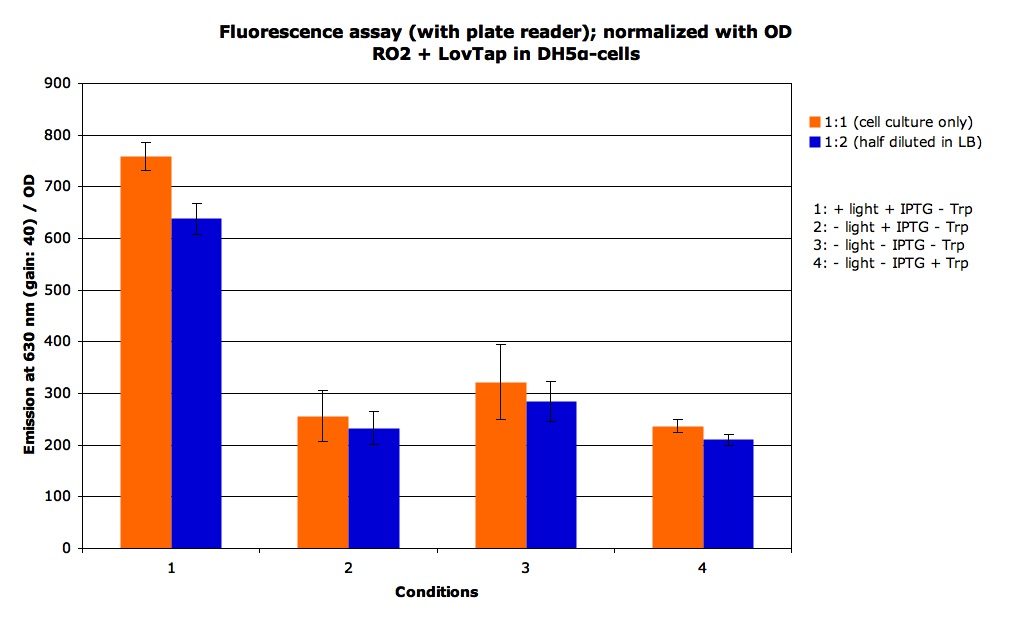EPF-Lausanne/4 October 2009
From 2009.igem.org
Contents |
Wet Lab
Results of yesterday transformation
All 6 plates grew but it was a bacterial lawn so we had to replate them in order to have single colonies.
Colony PCR
... of the re-re-re-plated cells !
Gel
The one this has been made yesterday but only this morning. It isn't easy to see the bands... so we will do once again another gel !
... A COMPLETER !!!
Characterization
-> plate reader experiment of RO2.4 + BB1/#3 in LB.
Because it is the only clone / medium that show fluorescence on the qPCR experiment of yesterday. Same conditions as yesterday : +IPTG / +light / -TRP, +IPTG/ -light / -TRP, -IPTG / -light / +TRP, -IPTG / -light / -TRP.
2h30 illumination in 37°C 200 rpm shaking incubator (Sebastian's lab).
Cultures done in 8 ml LB with 1 ml of re-inocculation of the overnight culture (100 ul IPTG & antibiotic) : plate prepared under Red LEDs.
First gain = 95. Second gain = 40.
Results of overnight culture
- RO1.1 + BB1 /#1 - DH5a - LB
- RO1.1 + BB1 /#1 - DH5a - M9
- RO2.4 + BB1 /#3 - DH5a - LB
- RO2.4 + BB1 /#3 - DH5a - M9
- RO1.1 + BB1 /#1 - JW - LB
- RO1.1 + BB1 /#2 - JRG1046 - LB
They all grew.
But as the results of the qPCR experiment didn't show fluorescence for most of our clones (except) one, we only re-did this one (RO2.4 + BB1 /#3 DH5 a LB).
Characterization
Characterization of the newly obtained JRG/JW strains (today) + RO2.4 + BB1 /#3 DH5a LB (the one that worked yesterday).
So we had 6 clones, it makes 12 conditions (+ IPTG / +/- light).
Miniprep
We also did some minipreps for the sequencing, for the ones that didn't have enough DNA Friday.
Plate : Sample concentration :
- 15 ng/ul for all except : 25 ng/ul for RO1&RO2,
- Primer concentration : 3 uM
Gel
Of the re-re-re-plated JW4356-2 RO2.4 + BB1 and JRG465 RO2.4 + BB1.
Only the BB1 is there. No RO2. We thought that from this gel JRG #2 and JW #2 and 5 were double transformants (although it is hard to see the bands).
We took these three clones + JRG #4 for control.
Results of the characterization
To confirm the results from yesterday's experiment on the qPCR machine, we redid an experiment with the exact same conditions, but taking only the strain that worked, and we did the measurements on the plate reader so that we had the OD as well and could normalize the fluorescence intensities, to see whether the results were significant. The strain we tested was a DH5-alpha RO2.4 + BB1.3 double transformant, cultured in LB.
Protocol:
1. The day before the experiment, put cells in culture in 5mL of LB (or other medium). Leave overnight at 37°C.
2. For each condition to be tested, re-inoculate 1mL of cell culture broth into 7mL of fresh LB. Add all "additives": for Trp, dilution of 1/25, for IPTG 1/100.
3. Incubate cells in the different conditions for about 2h30 (the light state is important too: - light in box covered by aluminium foil, + light exposed to blue light only).
4. Load wells for plate reader, in daylight for the +light condition, and IN THE DARK OR ILLUMINATED BY OTHER THAN BLUE LIGHT for the -light condition.
5. Use plate reader to measure simultaneously the OD (600 nm) and the emitted fluorescence (630 nm, Texas Red). Also, when going to take the measurements, carry plate in DARK BOX. Set the plate reader so that you shake the cells orbitally at medium speed for about 20 sec before taking the measurements.
Graphic :
We also did a colony PCR of various RO2.4+BB1 clones in the TrpR-mutated-strains JRG ? and JW 4365-2, to see whether we did have double-trasnformants. Result: for some we seemed to see a VERY faint 2nd band on the gel, but apparently the transformations didn't work very well.
For those clones which seemed to have 2 bands, plus for the DH5-alpha strain which gave good results earlier (see above), we redid an experiment. We wanted to leave cells in experimental conditions for 1h and then do a time-course measurement with the qPCR machine to see whether there was an evolution after induction, but the qPCR machine was in use. We took a measurement with the plate reader, but there were no significant results. We think that the "new" strains are not double-transformants, and that the DH5-alpha strain didn't give a good contrast because the exposure time was too short.
People in the lab
Basile, Tu, Nath, Caroline, Gab


 "
"

